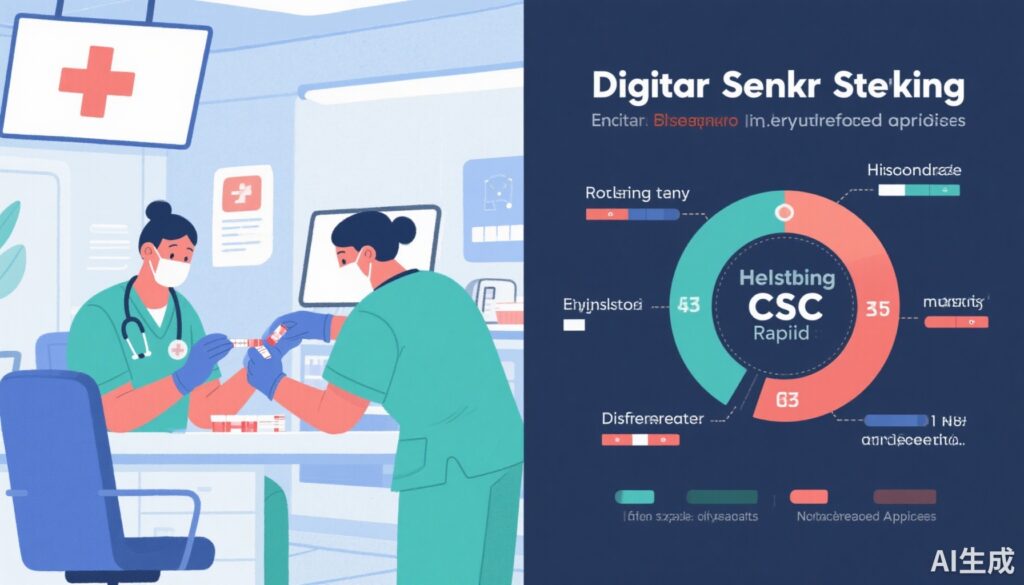Highlights
- Nontargeted HCV screening in emergency departments identifies significantly more new HCV infections compared to targeted risk-based screening.
- Despite increased case detection, linkage to follow-up care, initiation, and completion of direct-acting antiviral (DAA) treatment remain low across both screening strategies.
- The findings signal an urgent need to develop and implement innovative care models that enhance the HCV treatment continuum post-diagnosis in ED populations.
Background
Hepatitis C virus (HCV) infection remains a major global public health challenge, affecting an estimated 58 million people worldwide and leading to significant morbidity and mortality due to chronic liver disease, cirrhosis, and hepatocellular carcinoma. In the United States, approximately 2.4 million persons live with chronic HCV infection, with many unaware of their status. Identification of undiagnosed infections is critical to achieving HCV elimination goals set by the World Health Organization and U.S. health agencies.
Emergency departments (EDs) often serve as a safety net for patients with limited access to primary care, many of whom belong to high-risk populations including persons who inject drugs, racial and ethnic minorities, and individuals with socio-economic disadvantages. Consequently, EDs have been identified as strategic venues for HCV screening and diagnosis. However, operationalizing efficient, acceptable, and effective screening strategies in busy ED environments remains challenging.
Traditionally, targeted screening based on risk assessment has been the standard, offering HCV testing mainly to patients with known risk factors such as a history of injection drug use or prior incarceration. However, risk-based approaches may miss infections in patients who do not disclose risk or have unrecognized exposures. Nontargeted screening, offering tests broadly without risk assessment, is increasingly advocated but raises questions about feasibility, cost-effectiveness, and patient acceptance.
Key Content
Design and Methods of the DETECT Hep C Trial
The DETECT Hep C multicenter pragmatic randomized clinical trial, conducted from 2021 to 2024, enrolled 147,498 adult patients across three urban EDs located in Denver, Colorado; Baltimore, Maryland; and Jackson, Mississippi. Patients were randomly assigned to either nontargeted HCV screening—offering testing broadly regardless of risk factors—or targeted screening, where testing was offered based on a standardized risk assessment.
Exclusion criteria included critical illness, inability to give consent, or known prior HCV diagnosis. The primary outcome was identification of newly diagnosed HCV infection confirmed by RNA testing. Secondary outcomes included screening uptake metrics, HCV genotype and fibrosis staging, linkage to care, initiation and completion of DAA therapy, achievement of sustained virologic response at 12 weeks (SVR12), and all-cause mortality over 18 months.
Findings: Screening Uptake and Diagnosis
Among 73,847 patients randomized to nontargeted screening, 13.4% (9,867) underwent HCV testing, yielding 154 new diagnoses. In the targeted screening group (73,651 patients), 31.8% (23,400) had documented risk factors, of whom 6.3% (4,640) completed testing, resulting in 115 new diagnoses. The relative risk of detecting a new HCV infection was 1.34 (95% CI, 1.05-1.70; P = .02) favoring nontargeted screening.
These results demonstrate that nontargeted screening identifies more cases despite a lower testing rate, reflecting the broader offer of testing.
HCV Genotype, Fibrosis, and Follow-up Care
Genotypic distribution and fibrosis staging at diagnosis were similar between groups, consistent with the diverse urban populations served. However, a notable drop-off was observed across the care continuum: only 19.5% (nontargeted) and 24.3% (targeted) of patients linked to hepatology or infectious diseases follow-up. Subsequent initiation of DAA therapy occurred in 15.6% versus 17.4%, completion rates around 12%, and SVR12 achievement approximately 9% in both groups.
Comparison to Prior Evidence and Guidelines
Previous observational studies and pilot ED screening programs have suggested feasibility and acceptability of both targeted and nontargeted approaches, but randomized trial evidence had been lacking. The CDC and USPSTF recommend HCV screening for all adults aged 18-79 years and specifically endorse risk-based screening strategies. Though cost-effectiveness analyses favor broader testing under some models, operational data such as in DETECT Hep C are critical for policy and practice.
Challenges in the HCV Care Continuum Post-ED Diagnosis
The marked attrition from diagnosis to treatment completion highlights systemic barriers, including insufficient case management, fragmentation between EDs and specialty services, and patient socioeconomic determinants influencing retention in care. Despite potent, well-tolerated DAA regimens available, translating diagnosis into cure in ED populations remains a significant hurdle.
Expert Commentary
The DETECT Hep C trial addresses a crucial knowledge gap by rigorously comparing nontargeted versus risk-based HCV screening in the demanding and heterogeneous ED environment. The trial’s large sample size across ethnically diverse metropolitan settings enhances generalizability of the findings.
The superior yield of new diagnoses from nontargeted screening advocates for reconsidering screening protocols in EDs and supports broader implementation. However, the modest test acceptance rates even when offered broadly suggest additional patient engagement and education measures are needed. Moreover, the persistently low linkage-to-care and treatment rates emphasize that screening alone is insufficient.
Mechanistically, the success of nontargeted screening derives from circumventing underreporting of risk factors due to stigma, recall bias, or lack of awareness. Nevertheless, this approach requires adequate resources for rapid testing, informed consent, and post-test counseling within workflow constraints.
From a translational perspective, integrating point-of-care HCV RNA testing, immediate reflex genotyping, fibrosis assessment, and on-site initiation of DAA therapy coupled with robust navigation programs could transform ED-based HCV care paradigms. Innovations such as telemedicine linkage, peer navigation, and simplified treatment algorithms may mitigate barriers identified in DETECT Hep C.
Limitations of the trial include the focus on urban centers which may not extrapolate fully to rural or community hospital settings, and that only 18 months of follow-up data are available, limiting long-term outcome assessment.
Conclusion
The DETECT Hep C randomized clinical trial provides definitive evidence that nontargeted HCV screening in emergency departments identifies more new cases than targeted risk-based screening. However, the translation from diagnosis to sustained virologic cure remains inadequate, underscoring an urgent need for innovative, integrated models of care that streamline treatment initiation and completion in this vulnerable population.
Healthcare systems aiming to meet HCV elimination goals should prioritize expanding nontargeted ED screening programs while concomitantly developing comprehensive linkage-to-care pathways. Future research should explore implementation strategies, cost-effectiveness in diverse settings, and novel therapeutic delivery models to overcome attrition in the HCV care continuum.
References
- Haukoos J, Rothman RE, Galbraith JW, et al. Hepatitis C Screening in Emergency Departments: The DETECT Hep C Randomized Clinical Trial. JAMA. 2025;334(6):497-507. doi:10.1001/jama.2025.10563
- Centers for Disease Control and Prevention. Recommendations for hepatitis C screening among adults—United States, 2020. MMWR Morb Mortal Wkly Rep. 2020;69(2):1-17.
- U.S. Preventive Services Task Force. Screening for Hepatitis C Virus Infection in Adolescents and Adults: Recommendation Statement. JAMA. 2020;323(10):970-975.
- Green PK, Berry K, Ioannou GN. Impact of universal hepatitis C screening in the primary care setting. Am J Med. 2021;134(3):317-322.e3.
- Reau N, et al. AASLD-IDSA Recommendations for Testing, Managing, and Treating Hepatitis C. Hepatology. 2024;79(3):1035-1101.



